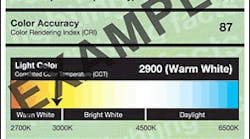The solid-state lighting (SSL) revolution taking place in the lighting world today was brought up-to-date at a conference in New York this past March. Sponsored by the Designers Lighting Forum of New York with support from the New York Section of the Illuminating Engineering Society of North America (IESNA), LEDucation IV featured key presentations focused on the topics of architecture, standards, and technology. As with any newer technology, quality standards will help speed market adoption rates.
Light-emitting diodes (LEDs) and sister technology, organic light-emitting diodes (OLEDs) — the two light sources that constitute the SSL category — have the potential to replace many light sources that either heat a tungsten filament to incandescence or that use filaments within a glass envelope to create an ionized arc stream (i.e., fluorescent and HID lamps). Thus, a presentation on three new standards by Michael Myer, lighting engineer with Pacific Northwest National Laboratory, Richland, Wash., was perhaps the most interesting for lighting practitioners, since the only way to separate false claims from accurate information regarding performance is through valid testing.
New lighting standards are necessary, because existing ones do not address LED characteristics, such as color consistency, lumen maintenance, and thermal effects. The two most important standards issued in recent years (2008) are:
-
IESNA LM-80, “Approved Method for Measuring Lumen Depreciation of LED Light Sources” — This standard sets up test conditions, including three different operating temperatures, to duplicate expected field conditions and equipment requirements. The lumen output is measured every 1,000 hr to at least 6,000 hr. The reduction in output at these six points is plotted on a chart and extrapolated for 36,000 hr. If the LED is tested for 10,000 hr, then the extrapolation extends to 60,000 hr. The end of useful life for a source is when 30% of its lumen output is lost.
-
IESNA LM-79, “Approved Method for the Electrical and Photometric Testing of Solid-State Lighting Devices” — This standard was developed to evaluate the performance of the LED source in a fixture. This is accomplished by evaluating how the light source performs in a fixture. Parameters covered include the testing conditions, how to operate and stabilize the LED sources, what instrument is used, and how to take measurements.
To address the unique color characteristics of LEDs, the American National Standards Institute (ANSI) published ANSI C78.377-2008, “Specifications for Chromaticity of Solid-State Lighting Products.” This standard specifies the range of chromaticities recommended for general lighting with SSL products and ensures that the white light chromaticities of the products can be communicated to consumers. The standard applies to LED-based SSL products with incorporated control electronics and heat sinks. The standard does not cover SSL products for outdoor applications or SSL products for some indoor applications that intentionally produce tinted or colored light.
Through creation of industry alliances, sponsored workshops, and its SSL CALiPER testing program, Energy Star certification program, and Next Generation Lighting Industry Alliance (NGLIA), the U.S. Department of Energy (DOE) is also helping LEDs gain market acceptance. In 2008, DOE launched an initiative called SSL Quality Advocates (QA), developed jointly with the NGLIA. QA is a voluntary program to ensure accurate reporting, not just in product labeling/packaging and literature, but also in press releases and manufacturers' data sheets. At the core of the initiative is a Lighting Facts Label (shown above) that is placed on a fixture carton, showing performance characteristics of the product.




